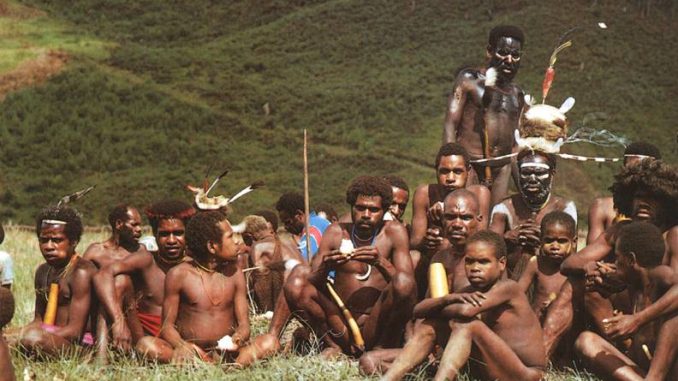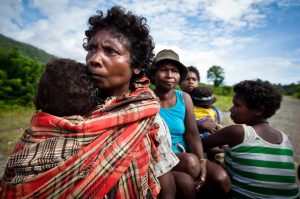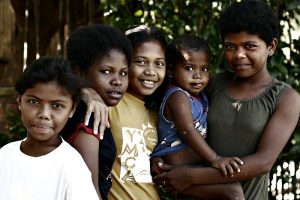
The Aeta are also considered to be ‘Negritos’ – a name given to them by Spanish conquerors. They have dark brown to extremely dark brown skin, kinky and curly hair which ranges in dark brown to blond, small noses, dark brown eyes and possess short height.

They are also called pugot or pugut, an Ilocano term which translates to goblin or forest spirit.
History
Due to internal strife within the tribe, disorganization and a weak mode of fighting off enemies, some Aeta were sold into slavery in Borneo and China during the 1500s, as documented by Miguel López de Legazpi, a Spanish navigator and Governor-General.
Their Current way of life
Due to deforestation, illegal logging, mining and slash and burn farming, the number of Aetas has dwindled down to the thousands.
How they came to the region is widely speculated. It is believed that the Aeta travelled to their current location from the Asian mainland using land bridges.
The Aeta have remained resistant to change and were not deeply affected by Spanish rule in the Philippines due to them remaining in the mountains. Attempts to migrate them to reservations were quickly quelled.
Like other nomadic African tribes, the Aeta are adept at using bows and arrows. They have been documented as being excellent warriors who can attack field workers or travellers that wander into their territory.
They use sticks covered with the palm of banana leaves to construct a transitory shelter. Modernized Aetas have ventured out of the mountain regions and into villages and areas free of mountains such as Pampanga and Tarlac. Contemporary Aeta tribe members use bamboo and cogon grass to build their homes.
The Aeta speak Mag-indi, Mag-antsi, Abellen, Ambala, and Mariveleño. They are also known to adopt the language of their neighbors.
Appearance and body augmentation
The Aeta intentionally wound themselves on their backs, arms, breast, legs, hands, calves and abdomens to form scars. In turn, the wounds are disturbed with fire and lime to produce pronounced scars, as told by Trip Down Memory Lane. Additionally, the Dumagat – a subtribe of the Aeta disfigure their teeth by using a file then add black dye to it later on.
Skills
Aeta women are known for being skilled herbalists and are sought to concoct traditional medicines.
Women in the tribe also hunt in pack using the assistance of dogs. “About 85% of Philippine Aeta women hunt, and they hunt the same quarry as men. Aeta women hunt in groups and with dogs, and have a 31% success rate as opposed to 17% for men. Their rates are even better when they combine forces with men: mixed hunting groups have a full 41% success rate among the Aeta,” according to Frances Dahlberg, author of Woman the Gatherer.
Tribe members use braided rattan and pig bristles to make girdles, necklaces and neckbands. Additionally, palm leaves are used to make raincoats and bark to make loin skirts and attire for women; women also weave mats and winnows. Men only make armlets.
The Aeta use Agung’s – a set of vertically suspended gongs that feature knobbed gongs to produce melodies.
Religion
People of the Aeta tribe are monotheistic and polytheistic. There are also practising animists.
Those who believe in one God worship Apo Na – a supreme deity that rules over lesser spirits. Others believe that entities such as the river, sea, sky, mountain, hill and valley possess spiritual elements and are alive.
Others who believe in multiple gods worship Gutugutumakkan – the supreme being who has the following displays: Tigbalog, Lueve, Amas, and Binangewan.
Kedes is the god of the hunt, Pawi is the god of the forest and Sedsed is the god of the sea.
Lastly, there are those who have converted to Christianity and have become Evangelical Protestants and Jehovah Witnesses.

CREDIT. https://kwekudee-tripdownmemorylane.blogspot.com/

How did they became Jehovahs Witnesses?
They may be black but they are not Africans.
la terre fait les hommes… ces humains sont nés si loin de l’Afrique et leurs ancêtres l’ont quitté depuis si longtemps qu’ils ne peuvent être qualifiés d’Africains… Tous comme les Européens (j’en suis un), même si nos ancêtres ont peuplé l’Europe en provenance d’Afrique (j’approuve cette théroie) il y a plusieurs milliers d’années, je ne suis pas un Africain. L’afrocentrisme excessif mène à des erreurs.
Then is it to confirm that Black people are the Original people of the planet?